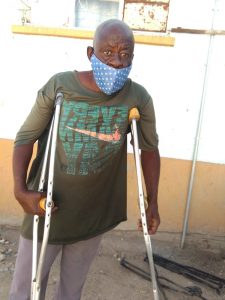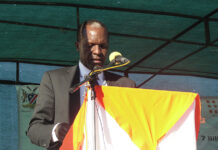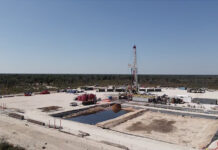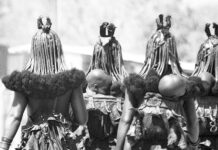By Timo Shihepo | 20 May 2021
WHEN Petrus Hoaeb (64) started working at the Rössing Uranium mine in 1976, he was hoping to escape poverty and to lay the foundation for a better life.
However, Hoaeb’s dream turned into a nightmare when he got sick in 2000 after he was allegedly exposed to radiation.
“That place is toxic and dangerous. Every day you were exposed to chemicals, acid and uranium,” he says.
At the time, the mine – in the middle of the vast Namib Desert near Arandis – was ranked the third largest in the world.
Hoaeb says he was recruited when Rössing Uranium was looking for employees across the country, and was discovered at Khorixas in 1976.
“Rössing then took us to Arandis, taking us through the induction process for the first week, and the medical process to see if we were fit,” Hoaeb says, recalling his first days at the mine.
His first job was that of a clerk.
That was the same year Rössing became operational.
Workers at the time dug uranium ore used for bombs and civil nuclear power by the British and United States military forces.
Some former workers say exposure to radiation from the mine has left them with life-long illnesses.
Hoaeb says this has left him with pneumonia, and that he was confined to a wheelchair in 2004.
He became so ill that he was sent on sick leave for 12 years until he was fired in 2012.
“[My] breathing has become difficult. I frequently collapse,” Hoaeb says.
He says he is currently in this situation because the mine lacked protective gear and other safety measures.
He feels neglected by Rössing and wants compensation to foot his medical bill of about N$6 000 a month, he says.
“No one from Rössing ever visited me after I was fired in 2012,” he says.
In 2013 Hoaeb took his case to the Labour Court.
His lawyer, Sisa Namandje, said in court papers that Rössing ordered Hoaeb to return to work despite his health condition, and without prior counselling.
Hoaeb was fired for being absent without leave after he failed to return to work because of his illness.
“This is the same place of employment which almost cost him his life and in fact bound him to a wheelchair,” Namandje said in court documents.
Hoaeb says other complications he suffers from include “blood on the kidneys and broken cells”, which has left him unable to drive his car.
At the time of dismissal Hoaeb was employed as a laboratory technician, earning N$11 000 a month.
Dr Mkhukuli Dlamini is quoted in the court papers as saying that “Mr Hoaeb’s illness has been complex and its occupational relatedness difficult to ascertain with the limited information we had at our disposal”.
Namandje challenged the decision to fire Hoaeb, but the case was dismissed during the 2013 Labour Court hearing.
TOXIC HISTORY
Hoaeb is among many former Rössing employees who complained about being exposed to radiation at the mine.
The impact of mining operations on workers has haunted Rössing for decades.
In 2015, the company commissioned a study through the University of Manchester to investigate if working at the Rössing mine is linked to a higher risk of developing cancer.
At least 76 cases were detected.
These include 32 cases of lung cancer, 18 other airway cancers, eight cases of leukaemia, nine cases of brain cancer and nine cases of kidney cancer.
The study warned that employees may breathe in radioactive dust and radon gas, which can escape from the rock.
The study was completed in 2019.
Rio Tinto has since sold its 68% stake in the mine to Chinese state-owned China National Uranium Corporation Limited for N$1,5 billion.
The study identified 7 901 people who had worked at least one year at the mine between 1976 and 2010.
It concluded that workers may also have inhaled other non-radioactive substances, such as acid mist.
The study identified those who had developed cancer by using the National Cancer Registry for both Namibia and South Africa, as well as information from the records of the mine’s occupational health service.
RIO TINTO CONFLICTED
Earthlife Namibia – a non-profit organisation – said Rössing Uranium is not being truthful with the study.
Earthlife Namibia’s Bertchen Kohrs told The Namibian this month that Rössing is not revealing all the content mentioned in the study.

“Professors of the University of Manchester approved the access to the full study; it seems it is Rio Tinto who is not interested in sharing it,” she said.
Kohrs said they sought scientists’ opinion when evaluating the PowerPoint presentation.
“We request a public admission from the Centre for Occupational and Environmental Health, the University of Manchester, Rio Tinto and Rössing Uranium that this study is of little value and cannot be used publicly as evidence that uranium mining is safe,” she said.
Kohrs also said the study is not correct because of the conflict regarding financial sponsorship to the University of Manchester by Rio Tinto.
“Rössing’s own data influenced the outcome of the study and controls how data should be released. This severely undermines the independence of the study,” she said.
SECRECY
Rössing Uranium spokesperson Daylight Ekandjo insisted that the University of Manchester study is legitimate.
“The final conclusion of the study conducted by the University of Manchester further supports that there is no greater risk to Rössing employees developing cancer than to anybody else working outside the mine,” she told The Namibian earlier this month.
She said the university found no strong evidence that radiation or other exposure increased the risk of developing cancer while working at the mine.
Some former employees have said the company has kept the study away from them.
Ekandjo said the findings were shared with “key stakeholders” and released publicly on Rössing’s website in January 2021, following delays because of Covid-19.
Ekandjo also revealed that the company is not in contact with former employees who may have developed illnesses because medical records are confidential.
“Compensation for workers claiming occupational diseases are determined following a process of individual case evaluation under the relevant legal and technical frameworks,” she said.
‘I STILL FEEL THE EFFECTS’
While Rössing is being secretive on publicly releasing the full report on the impact of its operations, some former workers continue to feel the pinch.
One of them is Otto Narib (65), who worked at the mine from 27 August 1979 to 26 September 1991.

He said the uranium from the mine affected him and caused health side effects, such as a stroke, which led to him being temporarily paralysed on one side of his body.
Narib recalls a period of sustained pain that led to Rössing Uranium mine’s in-house doctor booking him off for three weeks.
When Narib returned to work, he was eventually fired – because he was operated on, he believes.
“Years later my body became prone to sickness. Even today, I still feel the effects,” he said.
Narib said Rössing’s management has never visited him since 1991.
Sam Gaseb (64), who worked at the mine from 1978 to 1999, is partially paralysed.
He said he was retrenched after the company rendered him unfit for work.
“I was happy because I thought my life would change,” the former senior operator said.
He was earning N$15 000 a month.
Gaseb’s life changed, but not for the better.
“All that excitement vanished. I got a stroke and the left side of the body is now paralysed. I am unable to work.”
– This article was produced by The Namibian’s investigative unit. Email us: investigations@namibian.com.na






